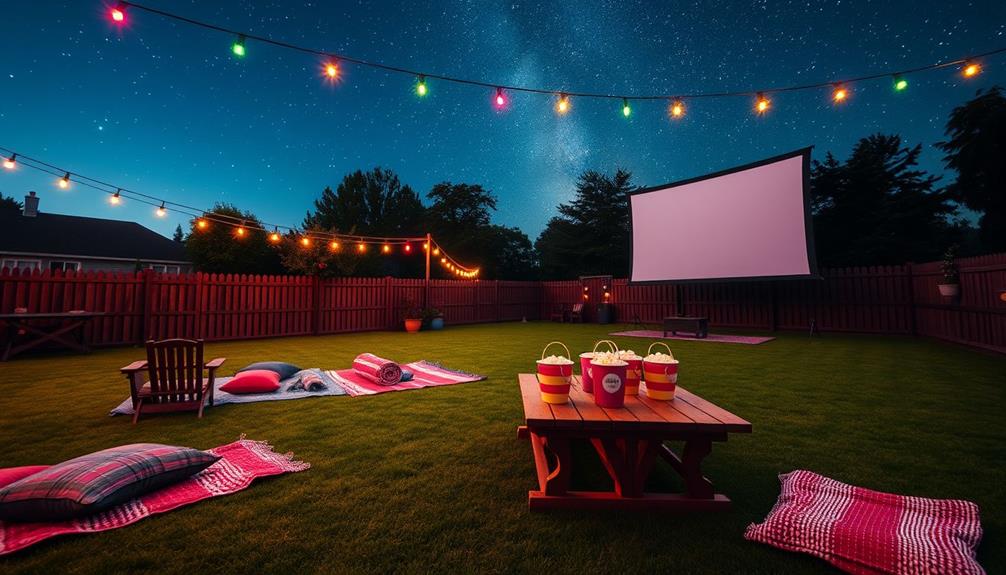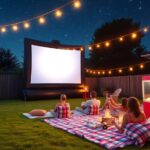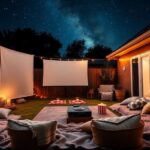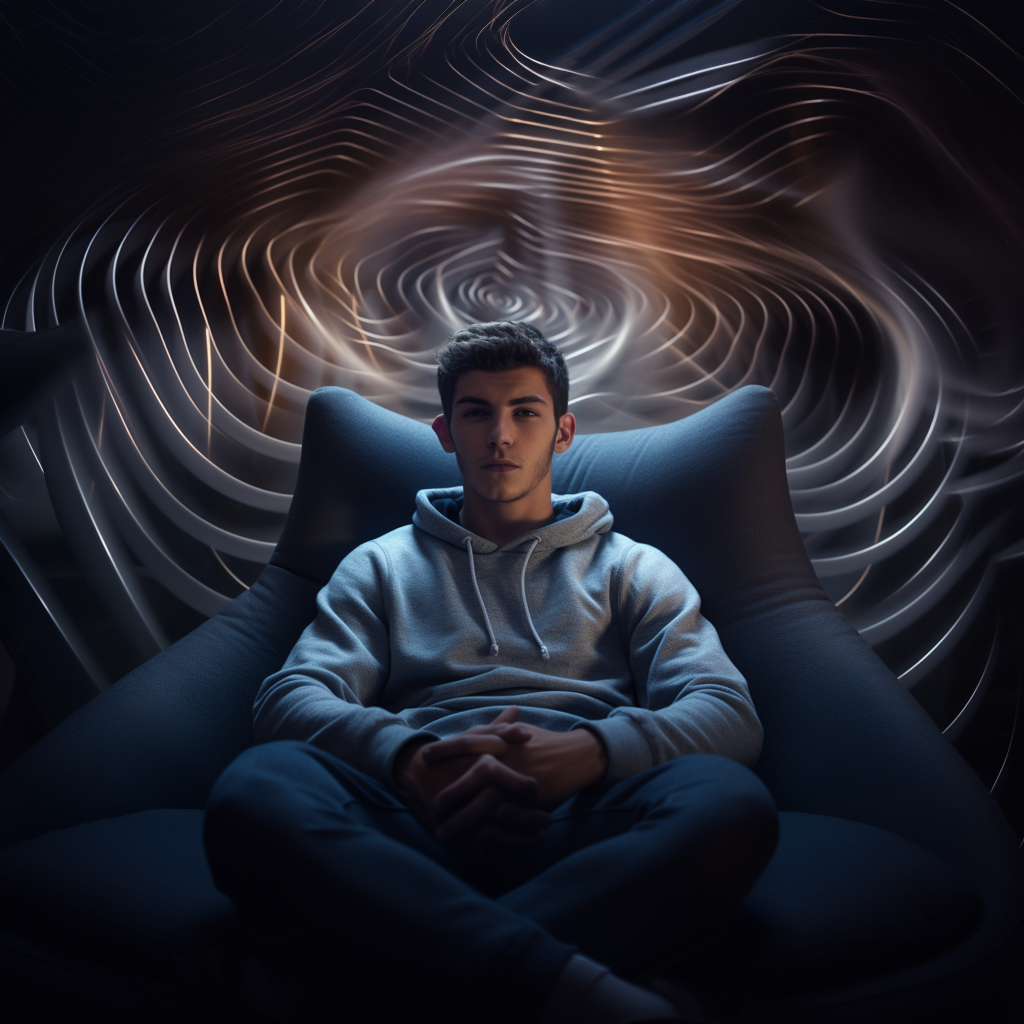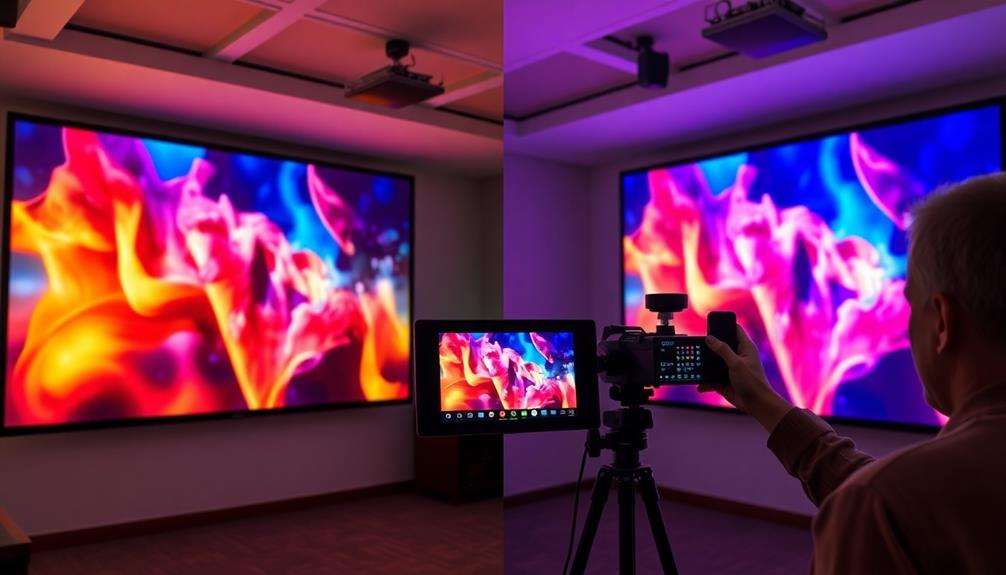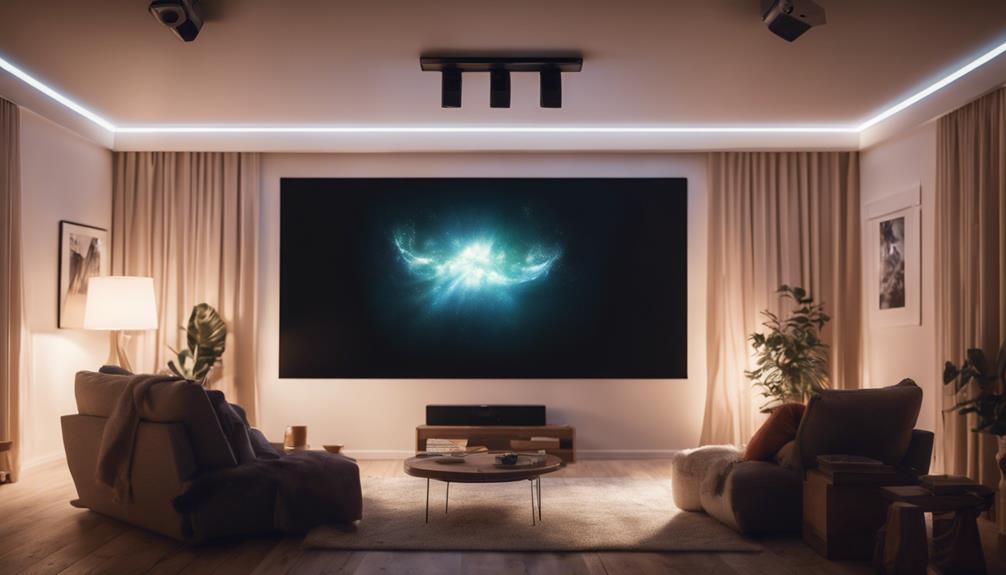You can easily create a drive-in movie experience in your backyard by starting with a spacious, flat area for parking and viewing. Set up a high-quality projector with at least 3,000 lumens and a large, dedicated screen for ideal viewing. Enhance the atmosphere with cozy seating like blankets and bean bags, and add string lights for a magical touch. Don't forget snacks! Serve popcorn, hotdogs, and themed treats at a mini concession stand. Finally, engage your guests with trivia or fun decor. You'll love transforming your space into an unforgettable movie night destination that friends and family will cherish!
Key Takeaways
- Select a spacious, flat area in your backyard for optimal viewing and parking for 10-15 cars.
- Choose a projector with at least 3,000 lumens and 1080p resolution for bright, clear images.
- Use a dedicated projector screen or inflatable screen for better image quality compared to walls or sheets.
- Create a cozy atmosphere with comfortable seating, themed snacks, and soft lighting using tiki torches and string lights.
- Enhance the experience with fun elements like cardboard box cars for kids and a concession stand for classic movie snacks.
Drive-In Movie History
Drive-in theaters have a rich history that dates back to the early 1930s, when the first one opened in Camden, New Jersey, on June 6, 1933, with the film "Wife Beware." This innovative concept quickly captured the American imagination, leading to a boom in popularity that saw nearly 3,000 drive-ins across the country by the 1950s.
The drive-in experience transformed into a cultural phenomenon, especially during the 1950s and 1960s, providing a unique social gathering space for families and couples. Many of these theaters featured breathtaking destinations, showcasing stunning landscapes that added to the overall experience.
As you create your own homemade drive-in movie experience, it's fascinating to reflect on how these theaters shaped American entertainment. The largest drive-in theater in the U.S., located in New York, accommodates an impressive 2,500 cars, showcasing just how beloved this format became.
Each visit to a drive-in theater offered an evening filled with laughter, romance, and nostalgia, elements you can recreate in your backyard.
Celebrating National Drive-in Movie Day on June 6 each year honors this rich history and the joy these theaters brought to countless moviegoers. With this legacy in mind, you're already on your way to crafting a memorable evening under the stars.
Choosing the Right Location
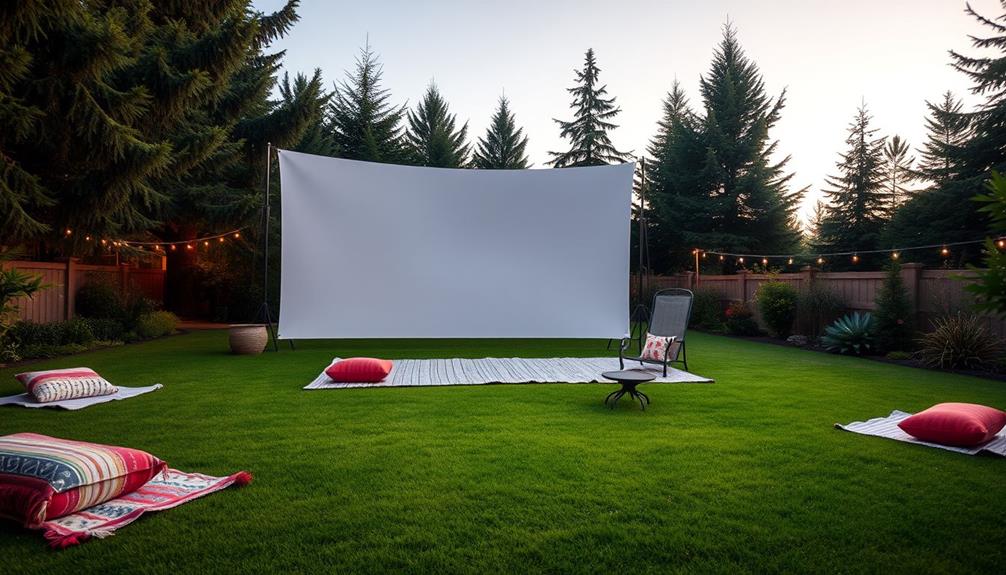
Selecting the perfect spot for your backyard movie night is vital to recreating that drive-in atmosphere. Start by choosing a spacious area that can comfortably accommodate your screen setup and parking spaces for at least 10-15 cars. This adds to the authenticity and allows your guests to feel like they're at a real drive-in.
Consider incorporating an outdoor ambiance, similar to the unique experiences found in stargazing and wildlife observation, to enhance your event.
Make certain the viewing area is free from obstacles such as trees or furniture that could block the line of sight to the screen from all seating positions. It's essential everyone gets a good view of the movie.
Additionally, consider how close the location is to power sources for your projector and audio equipment. You might need extension cords and surge protectors, so plan accordingly to avoid any tripping hazards.
Keep local noise regulations in mind, too. Respectful volume levels help prevent disturbances to your neighbors, especially in residential areas.
Selecting the Projector
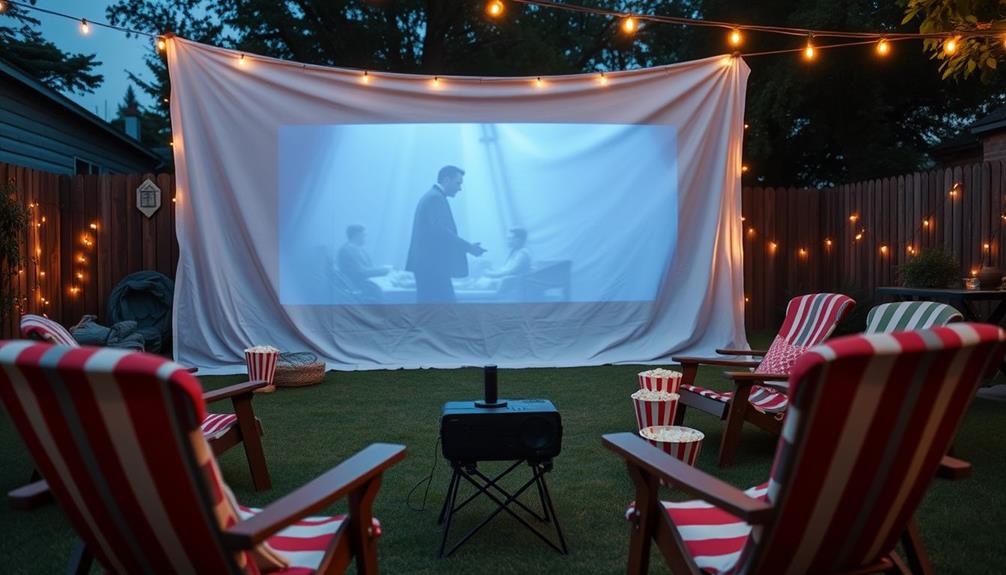
Once you've secured the perfect location for your backyard movie night, the next step is choosing the right projector to bring your cinematic vision to life. Selecting the right projector is essential for achieving that immersive experience, especially when projecting onto a large white inflatable movie screen.
Here are some key factors to take into account:
- Brightness: Aim for at least 3,000 lumens for ideal image quality, guaranteeing your movie looks great even as daylight fades. Additionally, reflect on the projector's ability to maintain clarity in various lighting conditions, which can enhance your viewing experience, similar to how projector maintenance tips can prolong the life of your device.
- Built-in Features: Look for projectors with built-in streaming apps and Dolby Audio sound to create a seamless viewing experience without extra devices.
- Portability: Think about portable projectors that don't require a plugin, allowing you to set up in various locations with ease.
- Resolution and Compatibility: Choose a projector with a minimum resolution of 1080p and verify it's compatible with your media source via HDMI connections for high-quality playback.
With the right projector, you'll transform your backyard into a fantastic drive-in movie experience that friends and family will love!
Importance of the Screen

The magic of outdoor movie nights hinges on the quality of your screen. A dedicated projector screen greatly enhances image quality compared to using walls or sheets, making your viewing experience clearer and more vibrant.
Choosing the right screen size is essential; it should suit your viewing area to guarantee everyone can enjoy the film without straining their necks or squinting. Aim for a minimum gain of 1.0 to assure proper video display and visibility for all guests.
Additionally, consider the environment where you'll be watching; making sure there are no strong odors, like citrus or vinegar, can help maintain a pleasant atmosphere for all attendees, similar to how cats dislike strong smells.
Inflatable projector screens are a fantastic option for outdoor settings due to their easy setup and portability, accommodating various audience sizes effortlessly.
Remember, the screen material you choose will impact your overall experience. Look for options designed to reflect light effectively and minimize distortion.
Positioning your screen correctly is just as important. Make certain it's free of obstructions, allowing for maximum visibility that enhances the enjoyment of the movie for everyone.
Enhancing the Experience

Creating an unforgettable movie night goes beyond just the film; it's about crafting an immersive experience that captivates your guests. To elevate the atmosphere, focus on enhancing sound quality by adding external speakers for better bass and surround sound. It'll make your backyard feel like a genuine theater.
Additionally, consider incorporating elements from Astrology and Attractiveness to tailor the experience to your guests' personalities, enhancing their enjoyment and comfort.
Consider your seating area—incorporate comfortable options like bean bags, blankets, and even inflatable pool floaties. This encourages relaxation and guarantees everyone enjoys the show.
Set the mood with tiki torches and string lights, illuminating pathways while adding a festive touch.
To keep spirits high before the movie starts, introduce interactive elements. Trivia games related to the theme of the movie can engage guests and create a lively environment.
Don't forget about refreshments! Offer a variety of themed snacks, like a build-your-own popcorn bar, to cater to diverse tastes and enhance the experience.
Here's a quick checklist to make your movie night memorable:
- Comfortable seating options
- Ambient lighting with tiki torches and string lights
- Interactive trivia games
- Themed snacks and refreshments
These touches will transform your backyard into an unforgettable drive-in experience!
Cardboard Box Cars

Enhancing your backyard drive-in experience can be even more fun with the addition of cardboard box cars. To create these imaginative vehicles, gather large cardboard boxes, packing tape, and a box cutter. Use one box per child to guarantee everyone gets the full experience.
Start by cutting a square from the top of each box for seating, leaving enough material for the hood. You might want to include a kid-sized chair or some comfy pillows inside for added comfort. This activity not only fosters creativity but also enhances teamwork and laughter as the kids work together on their designs.
Next, release your creativity! Paint the boxes in vibrant colors and fun designs, and use paper plates painted as wheels to enhance the look of the cardboard cars. Encourage the kids to decorate their boxes with stickers and drawings, allowing them to personalize their drive-in vehicles.
These cardboard box cars not only amp up the drive-in experience but also keep the kids entertained while waiting for the movie to start. Watching them race around in their creations adds an extra layer of joy to your backyard movie night.
Movie Screen Setup
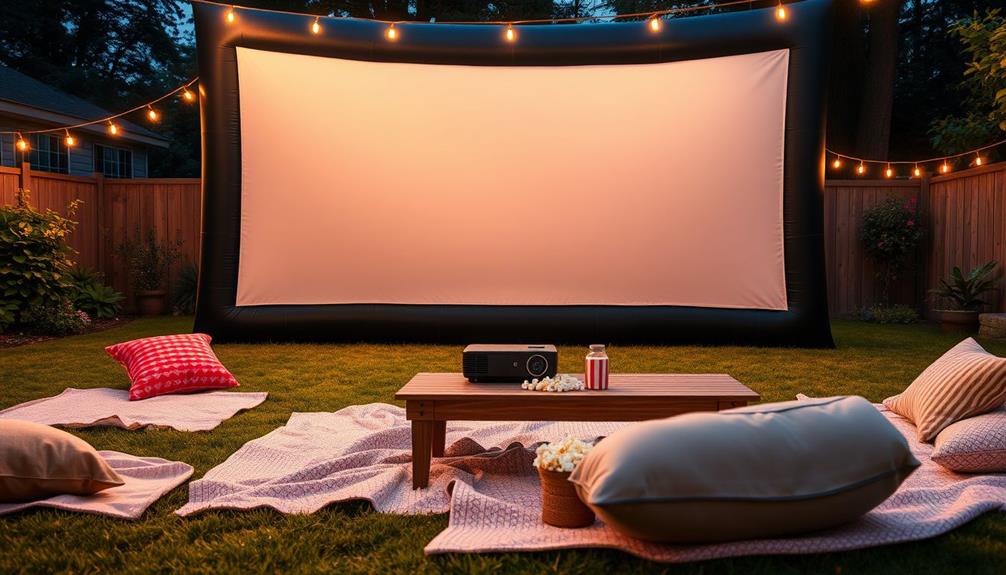
When setting up your movie screen, you've got a few options to evaluate, from a simple white sheet to an inflatable screen.
If you're looking for a fun atmosphere, contemplate incorporating elements from local attractions, such as the excitement found at water parks in Washington DC, which can inspire a lively backyard setting.
You'll also need to ponder where you place it, ensuring the location minimizes distractions and allows for ideal viewing.
Plus, connecting your projector properly is essential for a smooth movie experience, so make sure to have the right cables on hand.
Screen Types Available
For your drive-in movie experience, choosing the right screen is essential to secure a fantastic viewing setup. There are several screen types available to fit your backyard needs. Here are some popular options to take into account:
- Inflatable movie screens: These are a favorite for outdoor setups, typically costing around $150 and offering a large viewing surface. They're easy to set up and can be deflated for compact storage, making them convenient for occasional use.
- White sheet or blackout fabric: If you're looking for a simple and cost-effective alternative, a large white sheet can be easily attached to a wall or fence to create a makeshift screen. This option can be enhanced with proper placement to minimize wrinkles and guarantee a smooth surface for projection.
- Dedicated projector screens: For better image quality, these offer a minimum gain of 1.0, securing a clearer display than walls or sheets. Investing in a quality screen can greatly improve your viewing experience, much like using the right soil for your plants enhances their growth.
- Portable projector screens: Available in various sizes, these can accommodate different audience capacities, like the FunFlicks® Backyard screen for up to 100 guests or the Epic for up to 1500 guests.
Whichever option you choose, make sure your screen is set up in a location with minimal ambient light. This will enhance visibility and provide an overall better viewing experience for you and your guests.
Setup Location Considerations
Selecting the right screen is just the beginning; the location where you set it up plays a significant role in your drive-in movie experience.
Start by choosing a large, flat area in your backyard. This spot should have minimal distractions and obstacles to guarantee everyone has an unobstructed view of the movie screen. Consider enhancing the atmosphere with stylish wall clocks to keep track of time while enjoying the movie.
If you're using a large white sheet, secure it tightly to avoid wrinkles, as this enhances image clarity compared to projecting onto uneven surfaces.
Position your projector at an appropriate distance from the screen; aim for about 1.5 to 2 times the screen's diagonal size for the best image quality.
It's essential to align the projector and screen properly to prevent keystone distortion, which happens when the projector isn't parallel to the screen.
Projector Connection Methods
Connecting your projector to a media source is vital for a seamless drive-in movie experience. Using an HDMI cable is your best bet for high-quality video and audio transmission, so verify your projector and device are compatible.
If your projector doesn't have HDMI ports, you can explore alternative projector connection methods, but be aware that they mightn't deliver the same clarity. Additionally, make certain that you maintain proper plumbing practices during your event to avoid any inconveniences.
Here are some options to take into account:
- HDMI Cable: Best for quality; confirm compatibility.
- VGA or AV Adapters: Use if HDMI isn't available, though quality may suffer.
- Wireless Connections: Connect via Wi-Fi or Bluetooth for a clutter-free setup, but be prepared for extra configuration.
- Test Connection: Always test your projector connection before movie night to avoid technical hiccups.
Also, keep in mind the distance between your projector and the screen. Most projectors have a specific throw ratio, which dictates how far away they should be for ideal image size and quality.
Concession Stand Essentials
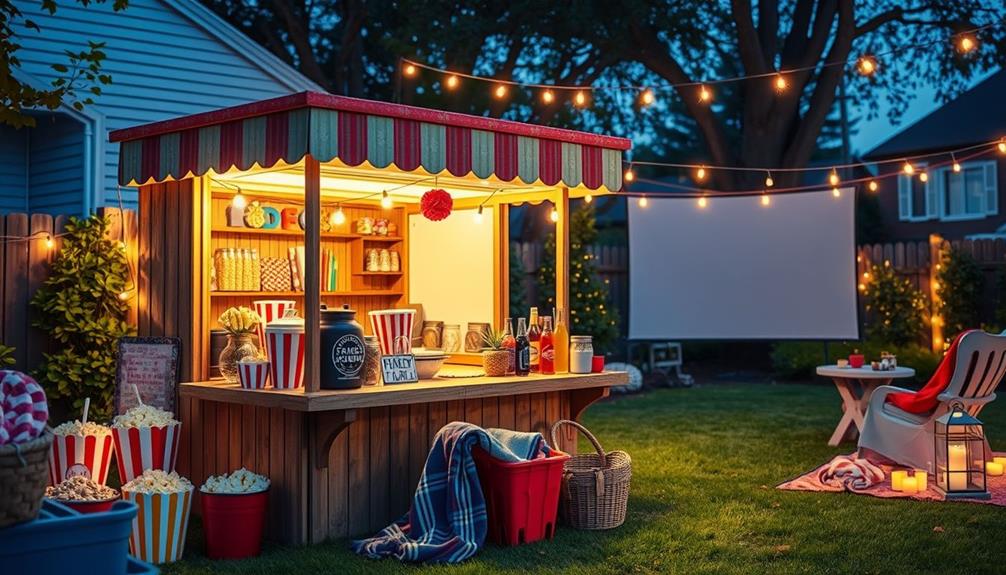
A well-stocked concession stand transforms your drive-in movie experience into a memorable event. By offering delicious refreshments, you'll keep everyone satisfied and entertained throughout the film. Here's a quick guide to essential items you should include:
| Snack | Description |
|---|---|
| Popcorn | Serve in plastic boxes or striped bags for a fun look. |
| Hotdogs | Use a portable cooker like a George Foreman grill for fresh, hot dogs. |
| Movie-sized Candy Boxes | Stock up on favorites like M&Ms and Twizzlers, easily found at dollar stores. |
| Themed Snacks | Match snacks to the movie theme for added excitement. |
| Drinks | Don't forget soda, water, and maybe some themed cocktails. |
Creating an inviting display on a picnic table or cart makes it easy for guests to grab what they want during the movie. This setup not only enhances the atmosphere but also brings everyone together for a shared experience. So, get ready to pop that popcorn and grill those hotdogs—your backyard drive-in is about to be a hit!
Entrance and Atmosphere
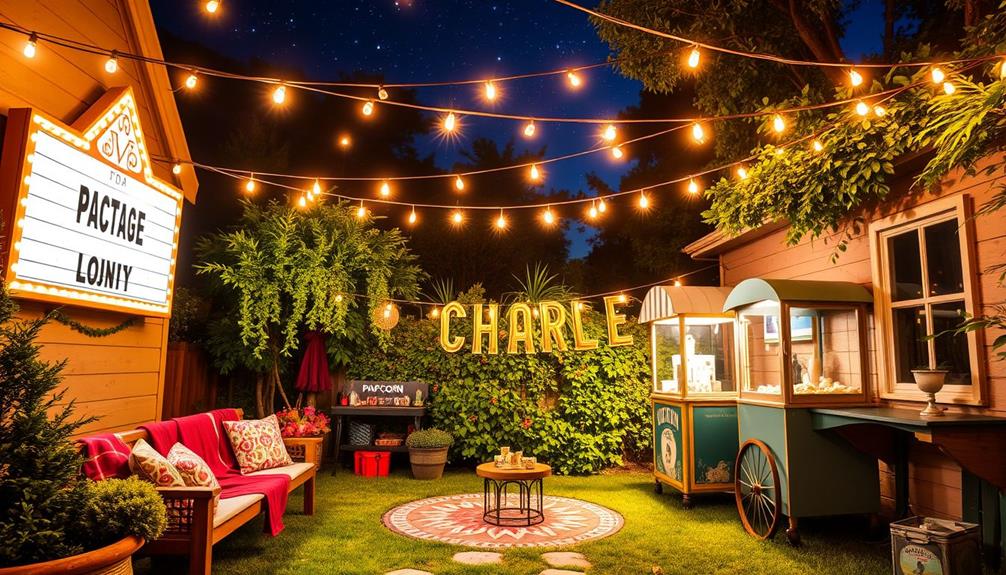
As guests pull up to your drive-in movie setup, a warm and inviting entrance sets the tone for the night ahead. Start by creating a charming welcome with a chalkboard sign that displays the movie title and showtime. This personal touch greets your guests and builds excitement.
Surround the entrance with vibrant movie posters printed on poster board to enhance the cinematic atmosphere. When guests arrive, hand out tickets—either printed or crafted—to mimic a traditional drive-in experience. These small details engage everyone in the theme and add to the fun.
To elevate the ambiance, incorporate soft lighting with tiki torches, lanterns, and string lights, fostering a cozy environment perfect for an outdoor movie night.
Here are a few more tips to boost the atmosphere:
- Create a chalkboard sign with the movie title and showtime.
- Decorate with colorful movie posters around the entrance.
- Hand out tickets to guests as they arrive.
- Add pillows and blankets on the grass for comfy seating.
With these elements, your entrance will captivate guests and set the perfect atmosphere for an unforgettable movie night under the stars.
Movie Night Experience
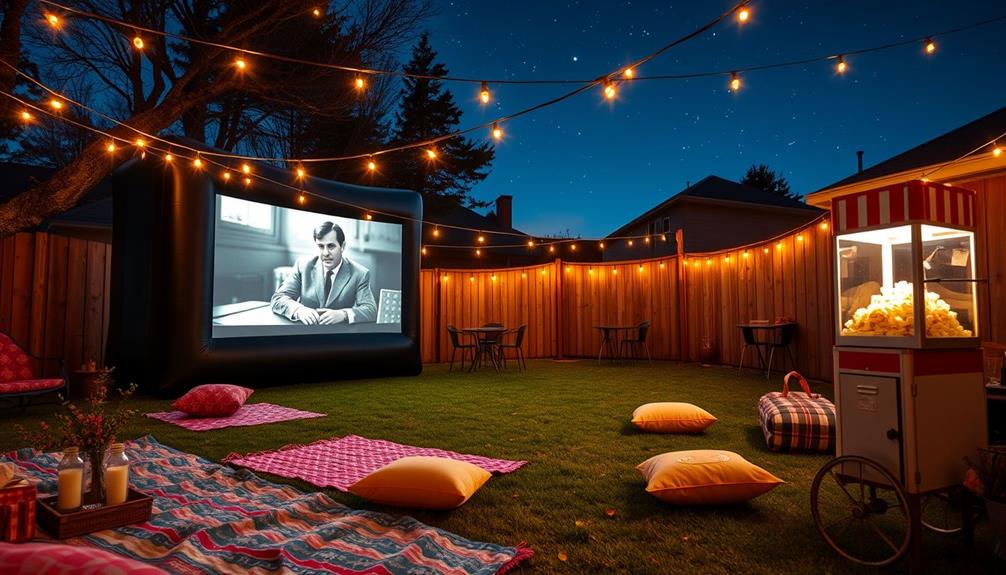
Choosing the right movie can set the tone for a memorable night, so aim for a family-friendly classic that everyone can enjoy.
To enhance the atmosphere, think about adding cozy lighting and a fun snack station that invites interaction.
With these elements in place, your movie night experience will be one your guests won't forget.
Movie Selection Tips
Crafting the perfect movie selection for your drive-in experience can set the tone for an unforgettable night.
To make your movie night enjoyable for everyone, consider these movie selection tips:
- Mix popular blockbusters and nostalgic classics: This caters to diverse audience preferences and boosts excitement.
- Opt for family-friendly films: Choose animated favorites or heartwarming stories to guarantee guests of all ages feel included.
- Schedule double features or intermissions: Pair complementary films to keep the energy high and engagement strong throughout the event.
- Incorporate interactive elements: Add trivia questions related to the films to spark guest participation and create a lively atmosphere.
Atmosphere Enhancement Ideas
Transforming your drive-in movie night into a memorable experience requires attention to the atmosphere. Start by using string lights and tiki torches to create a cozy, inviting vibe as the sun sets. These lights not only enhance the outdoor setting but also provide essential illumination for your guests.
Next, set up themed decorations like movie posters and fun props to immerse everyone in the cinematic experience. This sparks excitement and builds anticipation for the film.
Before the main event, play background music to engage your guests and set the mood. Encourage them to tune in through their car radios or portable speakers for an added touch.
Comfort is key, so arrange cozy seating options, including blankets, cushions, and lawn chairs, allowing everyone to relax and enjoy the show.
Don't forget to create a designated snack area with themed treats like a popcorn bar or a candy station, catering to diverse tastes and enhancing the overall movie night experience.
With these atmosphere enhancement ideas, you'll guarantee that guests leave with glowing memories of your drive-in movie night.
Conclusion
So, there you have it! You've transformed your backyard into a cinematic wonderland, complete with a projector that could rival Hollywood's finest—just don't forget the popcorn! Sure, your neighbors might think you're just a tad eccentric, but who wouldn't want to watch "Jaws" while dodging mosquitoes? As you settle in for movie night, remember: nothing screams "I've got my life together" quite like a lawn chair under the stars, surrounded by the smell of burnt popcorn. Enjoy!
Hello, I’m Art, and I’m excited to be a part of the 1Home Theatre Projector team. As a writer, I’m here to contribute my knowledge and insights to help you achieve the ultimate home cinema experience. I understand that making decisions in the world of home entertainment can be complex, and I’m here to simplify the process for you.
